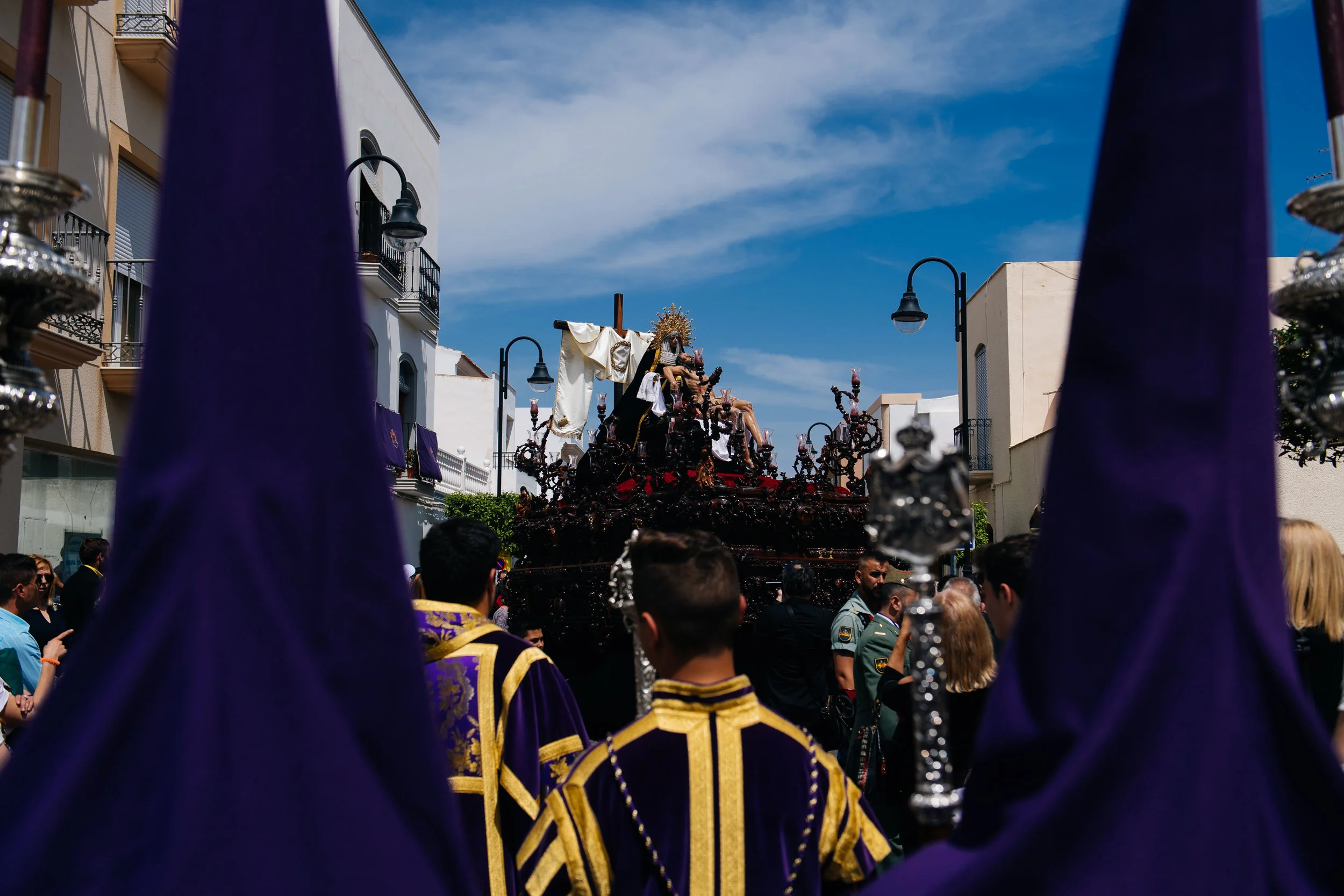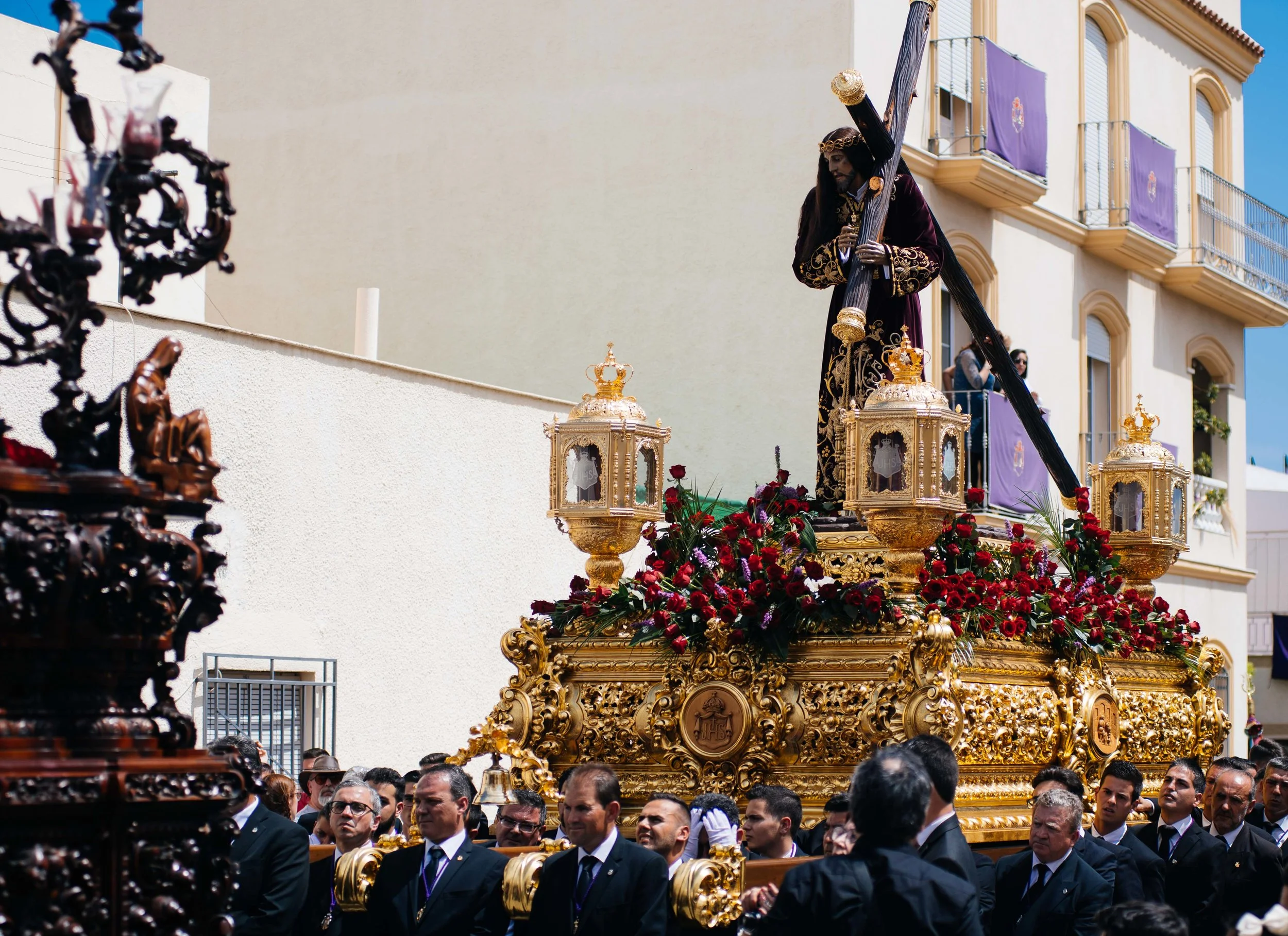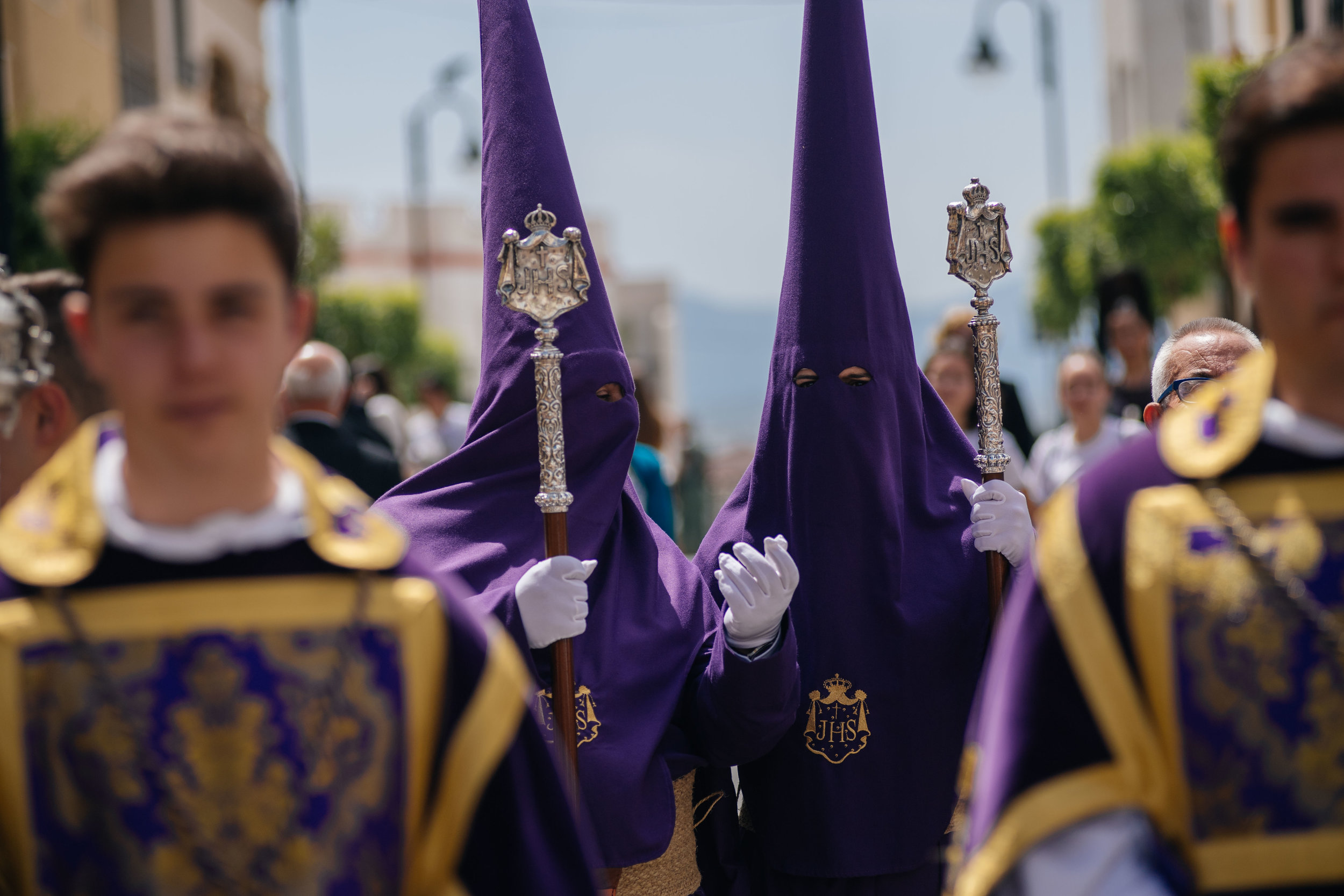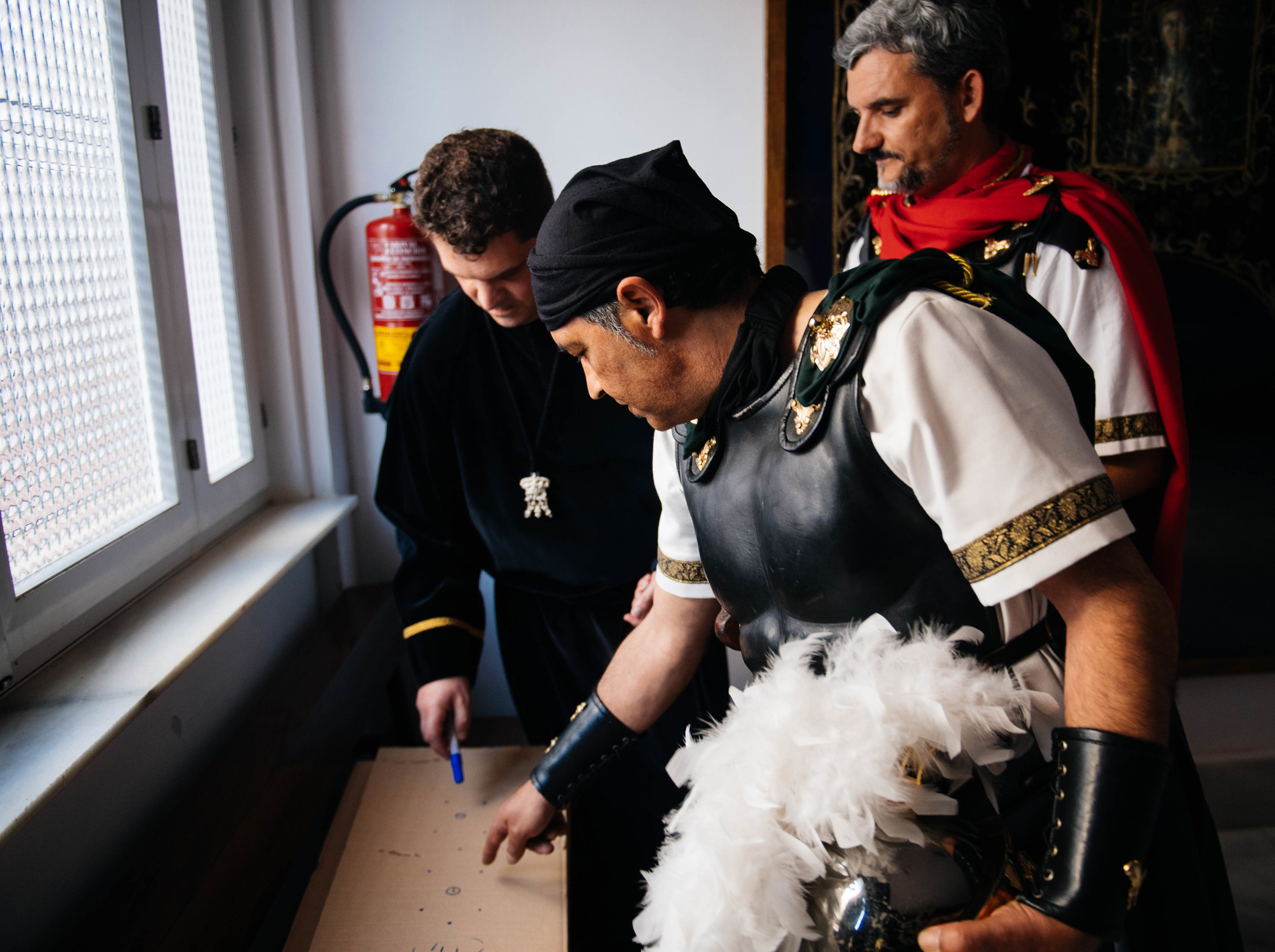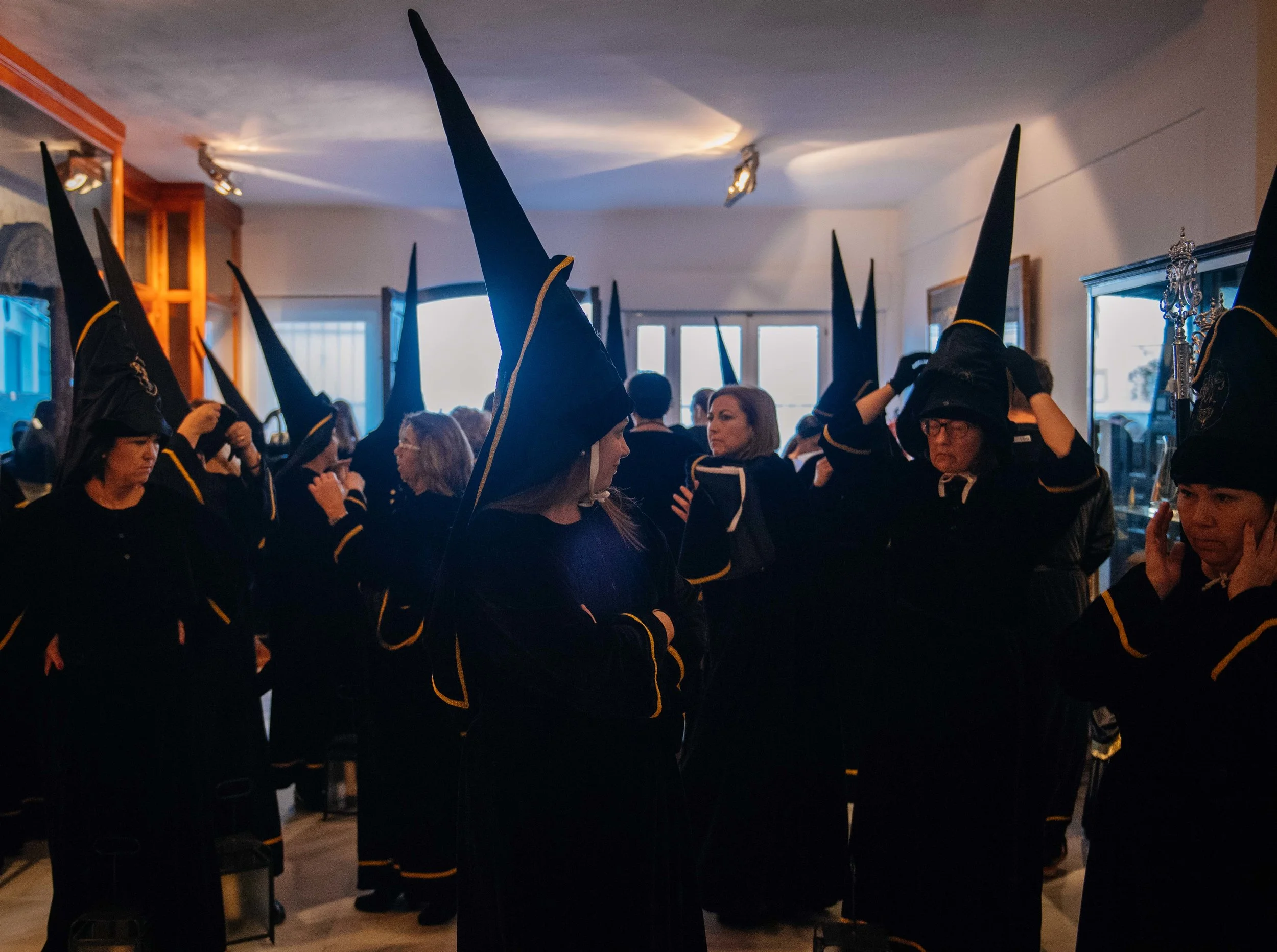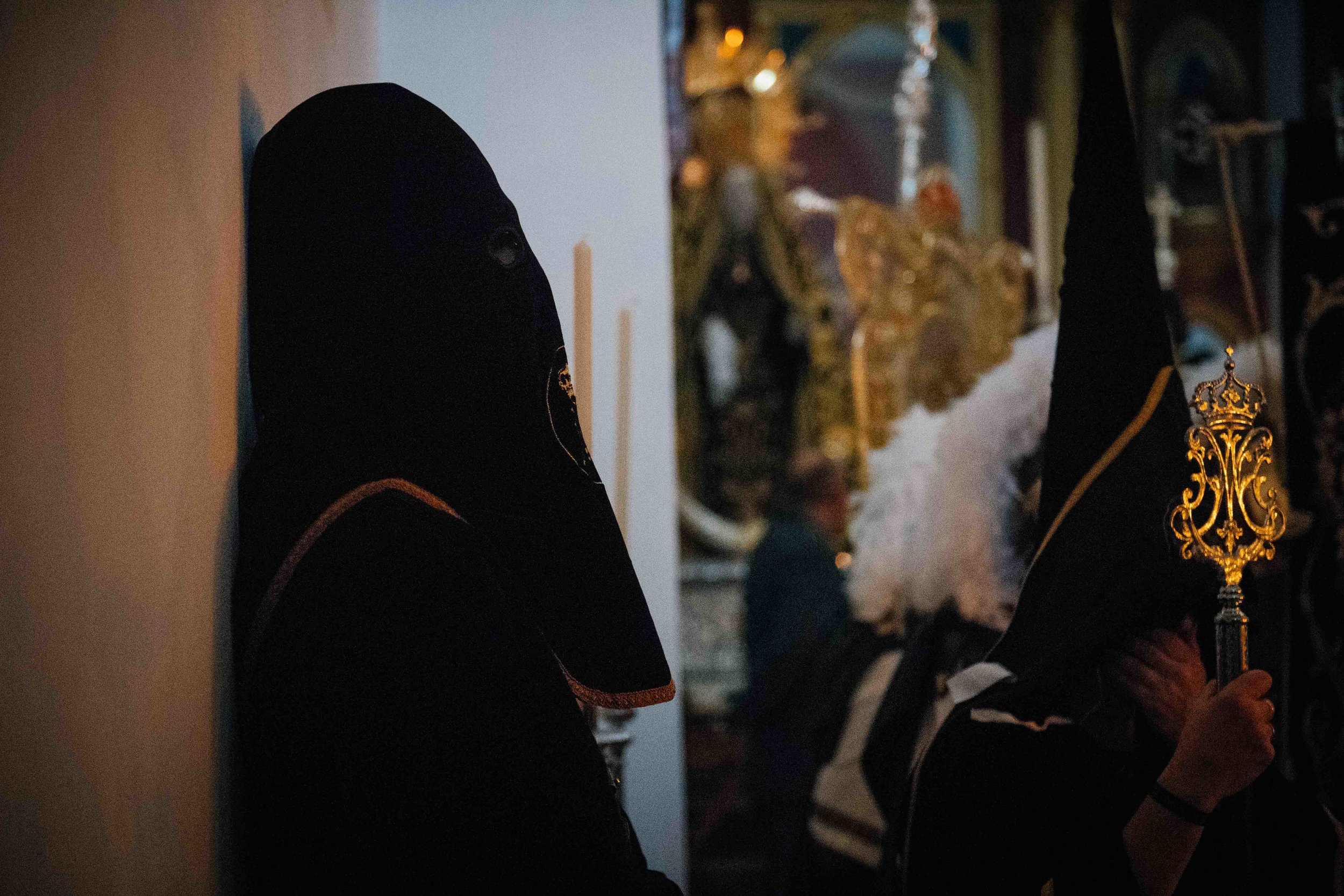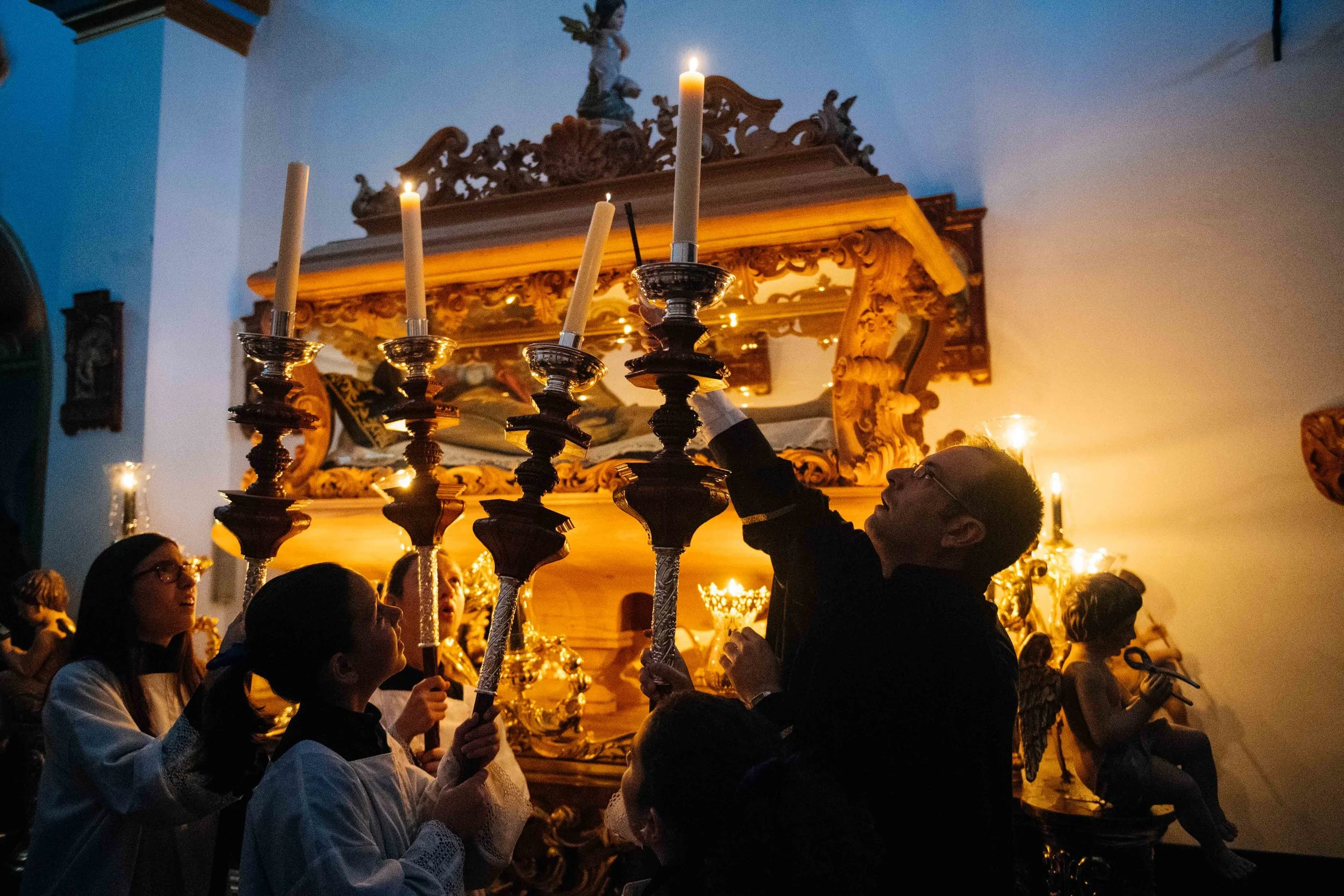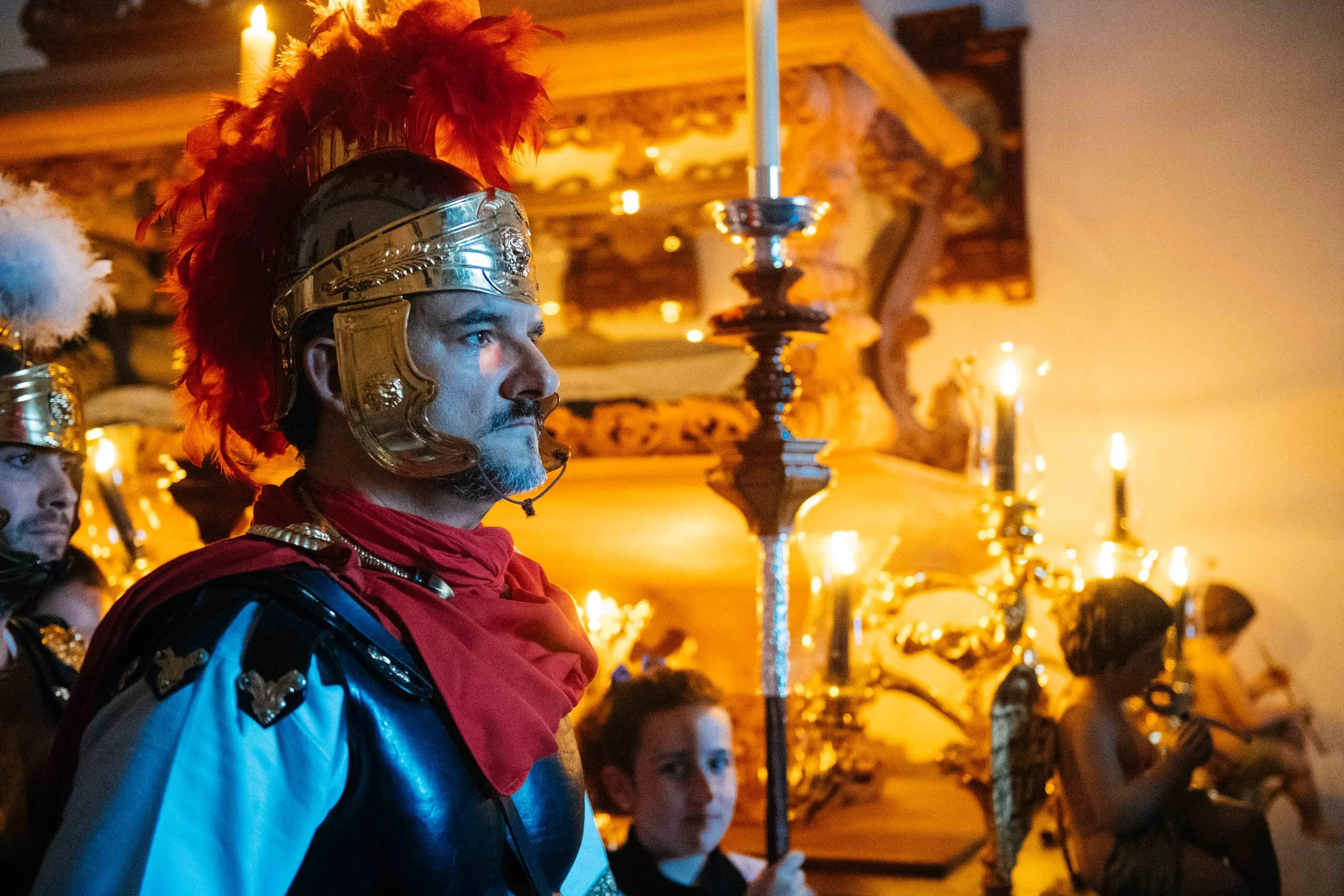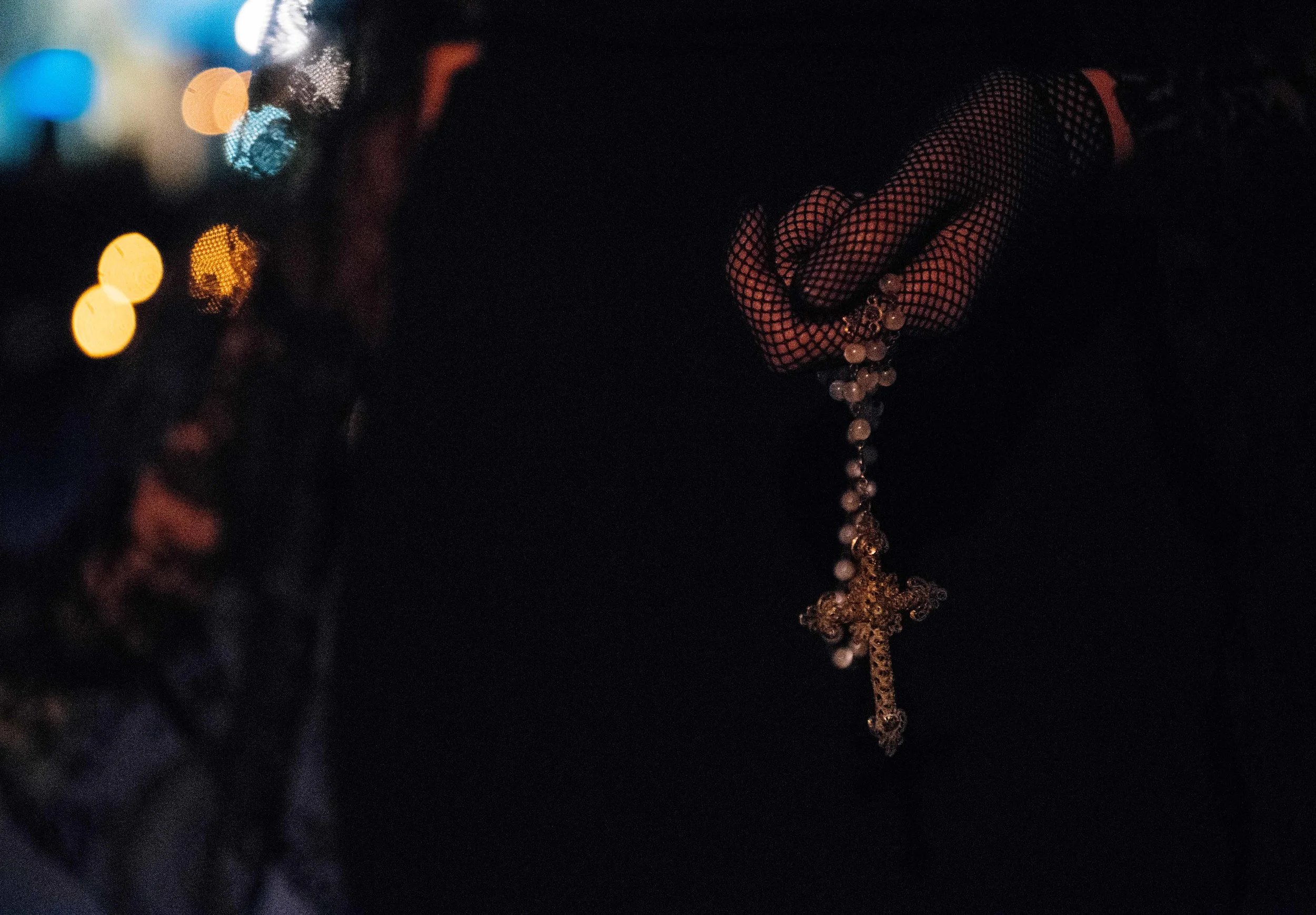Carrying the weight of tradition in Spain's Holy Week
Twenty-four-year old welder Antonio Caparrós breaks into tears while he hugs friends and relatives in a storage room with two gigantic, intricate, and beautiful statues and another few dozen sweaty men. He confesses that he has been released from a physical and emotional burden after having carried, along with another 39 men and for nearly five hours, a 1.1 ton statue of a Pieta, the depiction of a dying Jesus Christ in his mother’s arms.
Antonio Caparrós hugs a relative with tears in his eyes as he walks out from under the statue he was carrying. Caparrós every year takes part in the procession in memory of his late uncle that did it before him.
Text by Emma González | Photos by Bruno Maestrini | Originally written on April 16th 2017
For the last six years, Caparrós has been regularly taking part in the processions of the Holy Week in his hometown of Vera in southern Spain. His effort is not purely out of faith, but for something closer to the heart. ‘I participate because I really enjoy it, but also because I want to continue the tradition started by my late uncle”, explained Caparrós. “Most of us do it in memory of those who are not with us anymore”.
A pietá is carried by 40 strong men for several Km in Vera.
Jesus of Nazareth is carried on the Streets of Vera by "horquilleros" who walk in rhythm so that it seems that the statue is floating over the crowd.
Penitents talk at the final moments of the procession as the statues are stored in the back of the church.
The foreman is in charge of guiding the "costaleros" as they walk through winding streets at a very low pace. The foreman talks to the men inside giving them orders to turn, lift or lower the statue.
Holy week is the week before Easter and is one of the most important Catholic events in Spain, which took place in 2017 from April 9th to 16th.
Statue of Our Lady of Anguish has been part of the Vera procession since 1680.
These liturgical celebrations date back from medieval times and feature life-like wood sculptures of individual scenes of the Passion of Jesus Christ on top of intricately carved bases under which porters, or costaleros in Spanish, position themselves to lift the structure. The images, which can date back several centuries, are balanced on the back of the neck of 40 costaleros that march across the winding small streets of old Spanish towns for hours to pay tribute to the hardships suffered by Jesus.
The religious images are taken through the streets accompanied by penitents, usually dressed in heavy robes and in pointy, conical hoods, and watched by hundreds of thousands across the country. Despite Spain being a secular state, the theatrical rite is still strongly embedded in people’s lives and has great spiritual meaning for a large number of Spaniards.
In the town of Vera, in the southern province of Almería, around one third of the 16,000 inhabitants, take an active part in the Holy Week Processions. In fact, the importance of this event is such that some of the locals admit that they spend the whole year looking forward to the arrival of the Holy Week.
The processions are staged by religious brotherhoods, called Cofradías or Hermandades in Spanish. Originally in the 16th century, they had more of a social function such as that of assisting and taking care of the ill and needy. Nowadays, their main activity is focused on organizing the rite and raising money through charity events to preserve the religious images and the tradition.
Antonio Martínez makes a sketch and explained to the roman legionnaires how they should walk during the procession.
Representing Roman legionnaires, man holds banner with the initials for Senatus Populusque Romanus, the Roman senate and people.
The members of the brotherhood contribute with a small annual membership of at least 15 euro and other donations to pay for flowers and candles that appear during the procession. “The brotherhood lives for the Holy Week”, said Cristobal Gallardo, chief of the Brotherhood of the Real Archicofradia de Nuestro Padre Jesús Nazareno. “All the other activities we organize throughout the year are to raise funds for the Holy Week. We organize theater plays, choir performances and we even resell lottery tickets.”
Andrés Jerez, the treasurer of the brotherhood notes that the cofradía has an annual budget of 75,000 euro to organize the procession and to keep the images in good conditions. He added that the brotherhood invested 100,000 euro in the statue of the Pieta and that now they are saving to add ornaments to other of their images. Additionally, the brotherhoods expect that the investment will be returned in the city being officially put on the tourist destination map in Spain, helping to attract more tourists.
Moments before the start of the procession the candles that surround the statues are lit.
Maria José Rodriguez talks to another altar girl inside the church before the start of the procession.
In order to keep the tradition alive, the brotherhoods have to work in close collaboration with the Catholic Church. In fact, ruled by canonical law, the archbishop has to authorize the exact time and date the images can march the streets. However, the brotherhoods do enjoy some independence and are able to choose their own leaders democratically.
The town of Vera hosts 5 brotherhoods with an average of 500 to 600 members each. For the members, the brotherhoods help bring the social community together and are an act of collective participation that bolsters a sense of identity. The members choose to enter the cofradias either because of personal devotion to a specific image or to continue a family tradition.
“The brotherhood is an excuse to create social interactions”, noted Andrés Jerez. “The Holy Week is different for every person. For some, it might be a spiritual thing, for others it’s more about preserving a tradition, or it might be an opportunity to socialize”.
Penitents get ready and wait inside the church before marching out on the streets.
Costalero leans against the wall moments before lifting a 1.1 ton statue of Christ. They wear black clothing and hoods to seem invisible at night and the imagem of Christ appear floating on the streets.
Altar children have their candles lit before Holy Friday's procession. In the back, a coffin with an image of the body of Christ.
Light from outside doors through the doors on the face of a man dressed a Roman Legionnaire, accused of killing Jesus.
Penitents walk through the church door to meet the public and walk through the streets.
In recent years, the brotherhoods in town have widened to include women in all positions and now represent half of their membership. Traditionally, women have participated in the Holy Week processions as mourners, wearing an elegant but sober black dress with a traditional veil. As society evolves, more women are demanding to be included in every part of the ritual, and that includes being part of the group of porters that carry the heavy images and as penitents, with the conical hood and robe.
Three years ago, locals formed an all-women porter group to carry one of the images. “It is still quite uncommon to have women costaleras. There are only two groups in Almería, ours and another in the capital”, proudly explains Izaskun Veldarrain, a robust woman in her early thirties. Veldarrain and other 39 women lifted the 700kg plus image of Christ’s Foot Washing Ceremony.
Costalero awaits the foreman's order to lift the image of Jesus.
Candles are lit for a nocturnal procession, onde of the most visually impacting of the whole week.
Penitents walk the streets of Vera during Holy Friday's procession. Children don't wear hoods because they can feel constricting.
Costaleros wear black clothing and hoods to seem invisible at night so the image of Christ appears to be floating on the streets.
Traditionally, women have participated in the Holy Week processions as mourners, wearing an elegant but sober black dress with a traditional veil.
Many of the women in black, which some say represent the widows of Christ, carry rosaries and pray along the way.
For 12-year old María José Rodriguez, of the Venerable Hermandad de Nuestra Señora de las Angustias brotherhood, becoming a porter is not part of her plans. She hopes that she can finally dress the penitent robe next year after having walked in the procession as an altar girl since she was 5 years old. The heavy penitent hoods, with no holes to allow breathing, can be too claustrophobic for children, interrupts her mother. Therefore, most children that walk as penitents don't wear the hoods.
“I want to march with the adults. I know that I will be ready to wear the full robe next year”, confidently said Rodríguez, already looking forward to the coming Holy Week.


